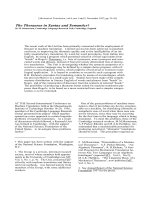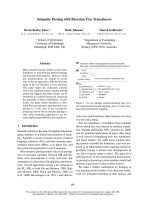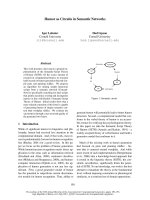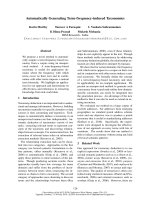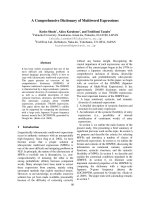Báo cáo khoa học: "AUTOMATED REASONING ABOUT NATURAL LANGUAGE CORRECTNESS" doc
Bạn đang xem bản rút gọn của tài liệu. Xem và tải ngay bản đầy đủ của tài liệu tại đây (469.08 KB, 6 trang )
AUTOMATED REASONING ABOUT NATURAL LANGUAGE CORRECTNESS
Wolfgang Menzel
Zentralinstitut f~r Sprachwissenschaft
Akademie der Wissenschaften der DDR
Prenzlauer Promenade 149-152
Berlin, II00, DDR
ABSTRACT
Automated Reasoning techniques applied to
the problem of natural language correct-
ness allow the design of flexible training
aids for the teaching of foreign langua-
ges. The approach involves important
advantages for both the student and the
teacher by detecting possible errors and
pointing out their reasons. Explanations
may be given on four distinct levels, thus
offering differently instructive error
messages according to the needs of the
student.
I. THE IDEA
The application of techniques from the
domain of Automated Reasoning to the
problem of natural language correctness
offers solutions to at least some of the
deficiencies of traditional approaches to
computer assisted language learning. By
supplying a specialized inference mecha-
nism with knowledge about what is correct
within fragments of natural language
utterances, a flexible training device can
be designed. It prompts the student
with e.g. randomly generated sentence
frames, where slots have to be filled in.
The system then accomplishes two main
tasks:
(I) It tries to diagnose possible errors
in the students response in order to build
up an internal model of the current
capabilities of the student in terms of
strictly linguistic categories.
(2) It gives an explanation of the diag-
nostic results to guide the student in his
search for a correct solution.
In contrast to other approaches (c.f.
Barchan et al. 1985, Pulman 1984, Schwind
1987) we concentrate our efforts more on
the handling of fragmentory utterances,
instead of trying to analyse the correct-
ness of complete sentences. The enormous
difficulties connected with the design of
a universal error diagnosis for natural
language sentences may only partially be
seen as a motivation for this restriction.
Other, equally important justifications
could be mentioned as well:
(I) The handling of only simple sen-
tence fragments seems to be a more natural
and transparent limitation compared with
an ad hoc exclusion of important parts of
the grammar from the rule system. Promis-
ing the student a universal sentence
acceptor, the real capabilities of which
are rather limited, may easily be mis-
interpreted as a kind of bluff, since the
consequences of such a cut will always
remain a mysterious thing to the student.
Severe restrictions on the grammatical
knowledge are inevitable at the moment,
but probably nobody will ever be able to
explain the language competence of a
training system to a learner of a second
language without totally confusing him.
Hence, minimising the problem of grammati-
cal coverage by accepting only fragments
of sentences, drastically improves the
prospects of finally achieving something
like a "water-proof" solution. Nothing
could be considered to be more harmful in
a teaching environment than to blame a
system's failure on the student.
(2) The concentration on small sub-
fields of grammar makes the determination
of very precise and detailed diagnostic
results possible. This, of course, is not
so much important if seen only for the
purpose of direct explanation: An explana-
tion overloaded with details is likely to
irritate the student. Nevertheless, a
very precise diagnosis is a sound basis
for building up a model of the current
capabilities of the student, which advan-
tageously may be used to guide the further
course of interaction.
(3) The approach allows a stepwise
extension of the degree of sophistication
while preserving the same basic principles
on all levels. This enables a rather
smooth accomodation to different per-
formance classes of hardware as well as an
easy adaptation to different paedagogical
objectives. Indeed, there are good reasons
to expect the very simple examples (e.g.
the insertion of a correct German deter-
miner) to be well suited for practical
46
training purposes.
(4) The focus on selected grammatical
regularities facilitates a systematic
training, which from a didactic viewpoint
seems to be more promising than just the
unspecified invitation: "Type in an arbi-
trary sentence!" with the always present
risk to catch the system out. Here we
prefer to guide the student in a rather
unconstrained way by prompting him with
carefully selected sentence frames or
questions. To hide the limitations of the
dictionary, as usual, the domain context
of a simple exercise environment (a room,
a shop, an airport etc.) is used.
In its diagnostic capabilities the
presented approach shows a strong analogy
to the basic concepts usually applied
within a system of Automated Reasoning: a
hypothesis is verified to be in accordance
with a set of initial facts and a set of
rules, which for our special purpose model
the correctness conditions of a specific
training exercise. The initial facts are
given as a logical combination of syn-
tactic and semantic features describing
the grammatical properties of certain word
forms in the system prompt. The hypothesis
results from the the student's response
where word forms are internally represen-
ted by their associated features as well.
II. KNOWLEDGE REPRESENTATION
To formalize the correctness conditions
of natural language constructs in a lin-
guistically adequate manner we adopted two
basic operators from a dependency grammar
• model (Kunze 1975):
constraints of the kind:
(*** <destination> <condition>)
transmitters of the kind:
(<source> <destination> <category>)
Both of them operate on feature sets. A
constraint reduces the feature set of a
word form bound to the variable
<destination> to its maximum subset which
satisfies the given <condition>. Transmit-
ters
carry
features belonging to a speci-
fic <category> from a <source> to a
<destination>, changing the feature set at
the destination according to a predefined
agreement relation. Typical categories are
the ordinary ones: GENDER, NUMBER, CASE,
PERSON etc., but semantic or very language
specific features (like INFLECTIONAL
DEGREE for German, cf. ROdiger 1975) may
be used as well. Accordingly, by means of
these operators the conditions for the
morpho-syntactic correctness within a
CAT=PREPOS I TION
SELECT=DIRECTION
CASE
I,PREP-3 I
CASE
CAT=PREPOS ITION
SELECT=LOCATION
\
ARTICLE
CAT=POSSESSIVE-PRONOUN
DEMONSTRATIVE-PRONOUN
CASE I
NUMBER ~
I *NOUN I
CASE
CAT=NOUN GENDER
INFLECTIONAL-
~
GREE
CAT=ADJECT IVE
Figure I: Correctness conditions for a special German prepositional phrase
47
simple German prepositional phrase of the
type (PREP DET ADJ NOUN) may be coded as
shown in ~igure i.
The " nodes in this graph denote
variables, which have to be bound to
single word forms. According to their
value assignment mode two types of
variables may be distinguished. Context
variables belong to the sentence frame and
receive their value (the feature set of a
specific word form) already during the
sentence generation process. The value of
a slot variable, however, depends on the
student's response and is established by a
pattern matching procedure based mainly on
word class information. The power of the
pattern matcher used determines almost
completely the flexibility of the system:
A rather simple one, using obligatory slot
variables only (hence, restricting the
slot to a fixed length) will be sufficient
under certain circumstances. The additio-
nal use of optional slot variables allows
the implementation of more diversified
exercises. Sometimes even a simple parser
for sentence fragments may be required.
The transmitters obviously constitute
the part of rules within the knowledge
base. They can easily be interpreted as
defining logical implications, semantical-
ly extended by two existential quantifiers
for the variables <source> and
<destination>. In a certain sense trans-
mitters correspond to the well known
Constraints:
(***
(***
(***
(***
(***
(***
(*** *ADJ
*PREP-4 (CAT PREPOSITION))
*PREP-4 (SELECT DIRECTION))
*PREP-3 (CAT PREPOSITION))
*PREP-3 (SELECT LOCATION))
*NOUN (CAT NOMINAL))
*DET (CAT ARTICLE
POSSESSIVE-PRONOUN
DEMONSTRATIVE-PRONOUN))
(CAT ADJECTIVE))
Transmitter:
(*PREP-4 *NOUN CASE)
(*PREP-3 *NOUN CASE)
(*NOUN *DET CASE)
(*NOUN *DET NUMBER)
(*NOUN *DET GENDER)
(*NOUN *ADJ CASE)
(*NOUN *ADJ NUMBER)
(*NOUN *ADJ GENDER)
(*DET *ADJ INFLECTIONAL-DEGREE)
figure 2: Rule set for the example in
figure 1
IF THEN rules in a typical expert
system.
The factual knowledge, on the other
side, consists of constraints (which could
be thought of to be transmitters with a
nowhere-source, indicated by "***" in the
rule set of figure 2) together with the
feature combinations in the dictionary
entries. Only from the point of view of
explanation the factual information has a
special status: one cannot ask for it by
means of a why-question.
III. ERROR DIAGNOSIS
Commonly one tries to distinguish the
field of Automated Reasoning from the
development of expert systems by comparing
a mean size of the knowledge base as well
as the length of a typical inference
chain. Normally, a system of Automated
Reasoning is expected to have a rather
limited number of rules but the ability to
handle extremely long chains whereas the
characteristics of an expert system
include plenty of rules but very short
inferences. In this respect, a system for
foreign language training belongs to a
third category, since both, the size of
the knowledge base as well as the mean
length of an inference path are com-
paratively small. Unfortunately, this
simplicity doesn't result in a very simple
design for the inference engine as well.
Difficulties arise from a peculiarity of
the language training task: On the one
hand, facts and rules are given to de-
scribe the c o r r e c t n e s s of
natural language constructs. On the other
hand, explanations are required about the
d e f i c i e n c i e s of a students
solution. Probably the system is never
asked to point out the reasons why a
specific inference can be drawn, but it is
expected to explain the reasons why a
correctness proof can n o t be
established. This, of course, requires a
special diagnosis procedure which in the
case of an error in the student's response
searches for plausible alternatives which
might have been leading to a correct
solution.
The diagnosis is carried out in two
steps (figure 3). Using a classical non-
deterministic forward chaining algorithm
the first step tries to show the correct-
ness by successively applying constraints
and transmitters on all the feature sets
previously bound to variables. A transmit-
ter can be applied, if its source doesn't
appear to be a destination in any other
48
transmitter waiting for application yet.
This implies that cycles of transmitters
are not allowed within the knowledge base,
a configuration which actually doesn't
occur in a natural language sentence,
anyhow.
The application of a constraint or a
transmitter fails, if it results in an
empty feature set at the destination.
Failures due to the missing of facts in
the knowledge base may indicate an error
in the students response, and all the
categories, variables and values concerned
are stored as failure points to be
analysed in detail later. A sentence frame
can be considered to be correctly
completed by the student, if all the
relevant constraints and transmitters have
been applied successfully. If such a
solution cannot be found (that is, a
mistake of the student has been
encountered), the second step resumes the
analysis by investigating the consequences
of assuming in each case just the
complementory feature set at the failure
point. By doing this, the diagnosis
procedure in fact tries to simulate the
ignoring of the corresponding rule by the
student and aims at finding out all the
resulting consequences.
To deliver the information needed by
the second step of the diagnosis procedure
requires to extend the capabilities of the
basic routine for feature set comparison
beyond the usual unification operations.
In addition to the normal intersection
between the relevant features at the
<source> and the <destination> the
procedure determines the complement of the
feature set at the <destination> (see
figure 4). To achieve the desired high
resolution of the diagnosis unification is
always carried out for a single category.
All the other features are left unchanged.
Given the case of an error in the
students response the investigation of
both alternatives, the intersection as
well as the complement becomes necessary.
That is, the diagnosis is confronted with
an enormous number of analysis paths.
Strong heuristic criteria are needed to
restrict the size of the search space
effectively. So far, an algorithm
considering only paths with a minimum
number of failure points has turned out to
be sufficient in most cases.
IV. EXPLANATION COMPONENT
Usually, due to the often numerous
morpho-syntactic readings of a word form
the diagnosis component comes out with a
couple of possible error interpretations,
all of them can by no means be explained
to a student without totally confusing
him. Again, heuristic criteria are needed
to reduce the number of interpretations in
a sensible way.
Step I: CORRECTNESS PROOF
Hypothesis
initial facts
Step II: INVESTIGATION OF INFERENCE
FAILURES
Hypothes is
I i
11/T2"
+
ILr gG
initial facts
c=
successful transmitter application
failure point
complementary transmitter application
possible error explanation
Figure 3: Two step diagnosis
49
[NOM1
CASE :
IGENI
L Acc]
l unified with I
[NOM]
CASE = |DAT|
[ACC]
I results in
: 1
CASE LAce]
CASE = [DAT]
(source)
(destination)
(intersection)
(complement)
Figure 4: Example for the extended feature
set unification
To select an appropriate (that is,
helpful from the students point of view)
error description the diagnostic results
have to be ordered by an estimated
explanatory power. So far, the following
criteria have been taken into
consideration:
(I) A category preference, which
chooses a certain transmitter function
(e.g. GENDER) as a more probable one. This
is a simple but obviously crude and
unreliable criterion.
(2) The distance between the complemen-
tary transmitter application and the hypo-
thesis, whereby errors "higher up" in a
sentence structure are preferred. For
example, it is more likely that the case
governed by a preposition has been mis-
taken than that the agreement within the
prepositional phrase is violated.
(3) In a multiple error diagnosis a
category common to most of the alterna~
rives could be taken for the explanation.
Given the very frequent error combination
(CASE and GENDER) or (NUMBER and GENDER)
missing gender agreement should be a
reasonable explanation.
A good heuristics certainly has to
include the structure of the dictionary
entries and the rule set in its investiga-
tion of possible alternatives. If there is
indeed a second reading with respect to
one of the hypothesised error reasons then
probably the student overlooked this
possibility. Here further investigations
are necessary.
From a paedagogical point of view it
would be desirable to explain the diagnos-
tic results (detected errors and their
possible reasons) on differently instruc-
tive levels, selecting the right one
according to previous results or current
desires of the student. The following four
levels seem to be appropriate and theore-
tically motivated:
(I) right/wrong answer without further
explanation
(2) explanation on the level of rules
(e.g. "missing gender agreement between
xxx and yyy")
(3) explanation on the level of facts
(e.g. "xxx is a feminine noun, hence you
should take a feminine determiner")
(4) explanation on the level of
examples using the inverted dictionary as
a data base to retrieve appropriate word
forms by means of the inferred feature
sets.
The verbalization of an explanation is
done on the basis of sentence schemata,
which have to be defined together with the
correctness conditions. On demand, the
actual categories, values or examples are
inserted and minor surface smoothing
operations are carried out.
V. DIALOG CONTROL & USER MODELLING
By carefully investigating a series of
responses a model of the current capabili-
ties of the student can be build up. Based
on this model the system autonomously may
vary different aspects of the dialog
behaviour. The most simple example is the
selection of one of the explanation
levels. The system switches over to a
deeper level of explanation if the student
either
repeatedly
fails to find the
correct solution or signals his inability
for understanding the previous error
message. It goes back to a higher level if
consecutive successes of the student
justify this.
A series of responses may contain hints
about where the weaknesses of the student
actually lie. Thus, in addition to the
criteria of section IV another heuristics
for the selection of diagnostic results is
available: Continued repetition of one and
50
the same error type will cause the
explanation to focus on this category.
Furthermore, the collected information can
be used to guide the training strategy.
Exercise generation may be controlled to
just concentrate on the weak points of the
student or even to alter the degree of
exercise difficulty.
VI. EXPERIMENTATION
To study some selected problems (espe-
cially the exploitation of heuristic rules
within the diagnosis and explanation
components) in greater detail, a first
prototype has been implemented. Currently
the system includes a random sentence
generator to supply the system prompts, a
simple pattern matcher for obligatory slot
variables, the two step diagnosis
described above and an explanation
component up to the level of facts.
The training examples studied so far
have mainly been taken from the area of
German noun phrase inflection (indeed an
intricate subject from the foreigne{s
point of view). The experiments confirmed
that simple versions of training exercises
may run already on very cheap type of
hardware (i.e. 8-bit micros).
the explanation mostly points out the
location of the error rather precisely.
(4) A model of the student% capabili-
ties is built up and the teacher is
supplied with a statistics in terms of
linguistic categories even in the case of
very complex or mixed exercises.
(5) Instead of explicitly listing them,
exercises can be generated automatically,
thus achieving a variety which almost
excludes repetition even in the case of
extremely long or repeated training
sessions.
Limitations for the application domain
mostly result from the feature based
approach to knowledge representation. It
first of all predestines the solution for
the training of morpho-syntactic reg-
ularities (esp. agreement relations). To
handle problems of e.g. usage or style in
a sufficiently general manner seems to be
far beyond the current possibilities.
REFERENCES
VII. DISCUSSION
The design of foreign language training
systems based on fundamental techniques of
Automated Reasoning exhibits several
important advantages as compared with an
immediate implementation of the almost
trivial scheme a Pattern Drill Book is
based upon:
(I) Automated Reasoning allows more
flexibility. Not the one correct solution
is asked for. The student may choose
h i s solution within the limitations of
the dictionary (expressed by the exercise
environment). Dialog situations may easily
be simulated. Experimentation becomes
possible.
(2) In addition to the right/wrong
diagnosis further three levels of explana-
tion are available. A correct solution can
be generated just for the particular word
samples chosen by the student.
(3) It becomes possible to include
rather complex regularities between con-
text and slot variables. Nevertheless,
Barchan, J.; Woodmansee, B. and Yazdani,
M. (1985) Computer Assisted Instruction
using a French Grammar Analyser.
Research Report 128, Department of
Computer Science, University of Exeter.
Kunze, J. (1975) Abh~ngigkeitsgrammatik.
studia grammatica XII, Akademie-Verlag,
Berlin.
Pulman, S.G. (1984) Limited Domain
System for Language Teaching.
Proceedings Coling 84, Stanford: 84-87.
RGdiger, B. (1975) Flexivische und Wort-
bildungsanalyse des Deutschen.
Linguistische Studien, Reihe A, Sonder-
heft 1975, Berlin.
Schwind, C.B. (1987) Prototyp eines
Sprachtutorensystems fGr Deutsch als
Fremdsprache, KI-Rundbrief 44, Januar
1987: 42
Wos, L.; Overbeek, R.; Lusk, E. and Boyle,
J .(1984) Automated Reasoning. Prentice
Hall, Englewood Cliffs.
51


